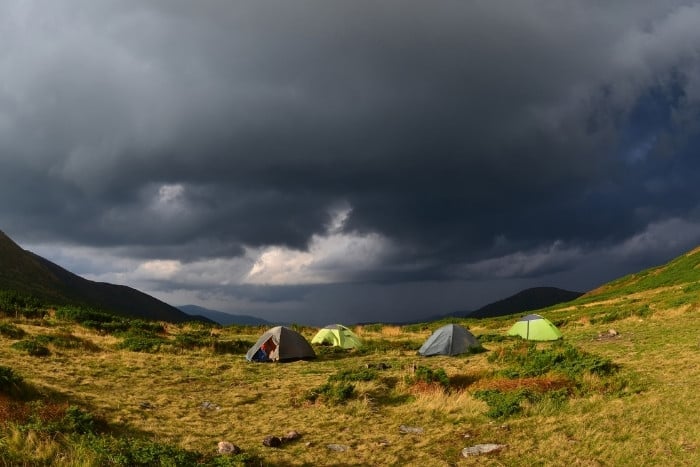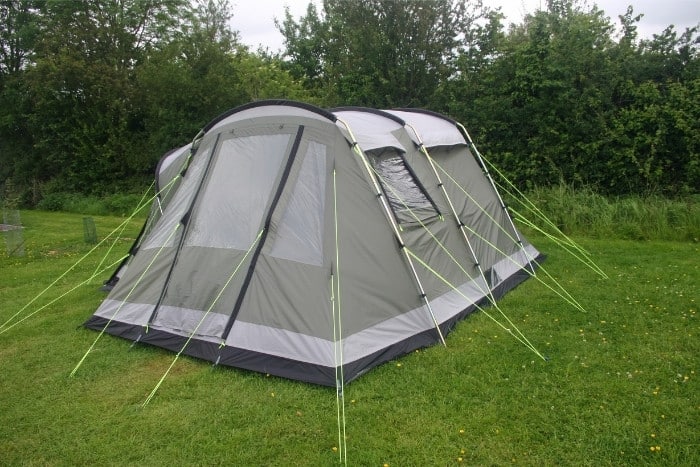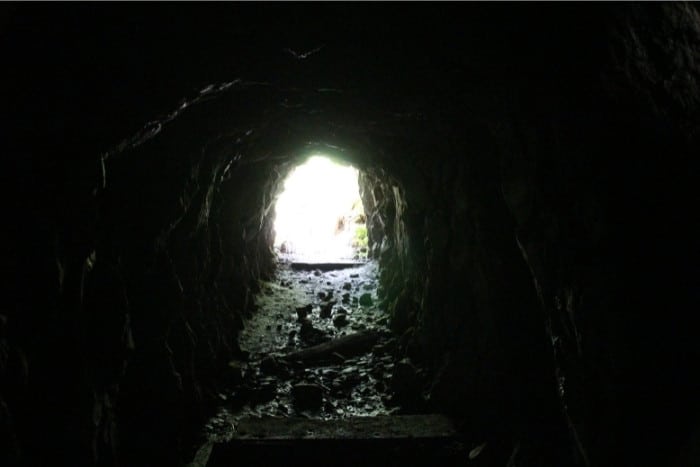You’ve been looking forward to this camping trip for quite some time, but now the weather forecast is calling for thunderstorms. You want to know if it’s still safe to camp during extreme weather and how you can safely do so. Are thunderstorms too dangerous for you to go camping?
Camping during a thunderstorm is dangerous but possible if you take proper precautions. Never stay in your tent. Seek shelter in a hard-topped car or a building with plumbing and electricity. Find lower ground and space out from other members of your party. Avoid trees and pack waterproof gear.
Here is what you need to know for more details on how to stay safe while camping in a thunderstorm.
Can You Camp During a Thunderstorm?
There’s no way for you to accurately and conclusively predict what the weather will be like during your next camping trip.
Many campers want to know what they can do to minimize their risk of injury during a thunderstorm.
Is it safe to camp outside if you know a thunderstorm is on the horizon?
Camping during a thunderstorm comes with some risks, particularly lightning strikes and wind damage.
Being soaked to the bone can also come with risks like hypothermia.
However, you can be safe if you know what type of precautions to take and pack accordingly.
A thunderstorm shouldn’t scare you off from moving forward with a camping trip you’ve already planned.
As long as you keep safety in the forefront of your mind and come prepared to face any type of weather, you aren’t likely to run into any major problems.
How To Camp During a Thunderstorm
Here are a few things you need to do if camping during a thunderstorm.
1. Get Out of the Tent
While it’s still possible to camp out in a thunderstorm, campers should be cautious about where they position themselves during the storm.
The ridgepoles of your tent are likely to act as a lightning rod.
You’re more likely to be struck by a wayward lightning bolt if your tent is the tallest thing in an open clearing.
Instead of remaining in your tent, hanging out in other parts of the campground is much safer.
You can sit at a picnic table or around the unlit fire pit if you have waterproof gear.
You’ll get nice and wet, but you can enjoy the storm from this vantage point with fewer worries.
You can also wait out the storm in your car for campers who don’t have waterproof gear with them.
You will want to seek shelter in a hard-top car because the metal frame acts as a Faraday cage to help protect you from the impact.
Hard-top cars struck by lightning will allow the charge to travel around the outside of the car without impacting the passengers inside.
Take this time to play a game or sneak in a quick nap.
Alternatively, you can also take shelter in a building fully equipped with electricity and plumbing, such as a bathroom.
Wait until the rain and thunder let up before you brave the trip back to your campsite to see the damage.

2. Avoid Open Buildings
Never seek shelter underneath an open building that does not have plumbing or electricity, such as a communal bathroom.
Open buildings like barns, sheds, or picnic shelters carry a very strong risk of side flash if they are struck by lightning.
They might keep you out of the rain for a little while, but you run an even bigger risk by relying on them to keep you safe during an intense thunderstorm.
Once you hear thunder come in with the rain, it is time to seek adequate shelter.
3. Find Lower Ground
Depending on where you’ve set up camp, you might want to consider moving to lower ground.
Of course, be sure you don’t choose an area that could flood or pool rainwater.
Lower ground means you aren’t sitting above the tree line or on the precipice of a ridge.
These spots could make you the target for an errant bolt of lightning. Lightning is much more likely to hit the tallest item it can find.
You want to ensure that you aren’t the tallest item in the surrounding area, or you might be fried when the thunderstorm starts to intensify.
Always avoid areas that appear to hold water. Ravines and other examples of lower ground can easily flash flood without warning.
This results in wet gear for you and could carry your items in the current of the water, making you lose important items that you’ll need later on.
As a rule of thumb, small ravines are more likely to flood than larger ones.
4. Avoid Trees
Keeping your campsite away from the trees might seem impossible, but it’s necessary if you’ll be camping during a thunderstorm.
Tents positioned directly beneath a tree are risky for several reasons.
First, you’ll be at greater risk of being hit with a side flash if that particular tree is struck by lightning.
Second, you could be parked directly under a “widow-maker tree.” Trees with weakened branches or dead limbs could shed those appendages in a serious storm.
If your tent is directly beneath, you could be seriously injured or even killed by the falling limb, depending on the size of the limb and the height of the fall.
Third, a tree that is struck by lightning can catch fire easily and transfer to your tent if nearby.
You could be trapped within a burning tent, leading to serious injury.
This also means that you want to avoid hanging out in your hammock during an intense storm.
You’ll be too close to the trees and could potentially be injured by their proximity if lightning comes too close.
5. Pack Waterproof Gear
You’ve checked the weather forecast before you head out on your camping trip.
When the meteorologist calls for thunderstorms, ensure you have waterproof gear packed in your car for the upcoming trip.
A summer thunderstorm may not harm you much if you get soaked in warm weather.
However, early spring, late autumn, and even winter camping can pose a different problem. Allowing the rain to soak you might feel fine or a bit uncomfortable.
If you have nothing else to change into or all of your clothes and gear are wet, you could come down with a case of hypothermia.
As the water dries, you are likely to feel a bit chilled.
Either pack backup clothing changes to keep in the car after the storm or invest in high-quality waterproof gear.
6. Double Check Guy Lines
In a thunderstorm, the biggest risk is the wind more than thunder and lightning.
Double-check your guy lines and put out some heavy-duty ones to keep your tent secure and dry when you notice a storm is starting to blow in.
You should also make sure to double peg them whenever possible. Keep some extra pegs in your camping gear if you need them while camping.
Shoring up your guy lines could be essential, depending on how aerodynamic your tent is.
If the wind catches your tent at the right angle and velocity, it could blow away and take you with it if you’re hunkered down for the storm.
Many become complacent when utilizing the guy lines that come standard with their tents.
If you know that you will be camping during a thunderstorm, preemptively use all of these guy lines to keep the rain fly from touching the inner wall of the tent.
You can also use them to secure a rain tarp to help you stay dry and avoid hypothermia.

7. Bring a Camping Tarp
Tarps are a great multipurpose tool that comes in handy during a thunderstorm if you want to ride it out.
To keep water from getting the floor of your tent wet, place an equally-sized tarp between the ground and the bottom of the tent when pitching it.
Make sure that the tarp is the same size as the floor of your tent for the best results.
Alternatively, a tarp can also be secured above your tent to keep the tent itself from getting wet. It can be held up by tent poles if you have them.
Otherwise, you can position your tent so that there are natural tie points for the tent, such as tree limbs (if you are sure that the tree is safe enough during the thunderstorm).
8. Avoid Ground Strikes
While many campers panic that the trees they’re camping near might be struck by lightning, there is another risk that might be much greater: ground strikes.
Electricity can travel along the ground and still cause harm, so put as much space between you and the ground as possible.
You can put many things on the ground between you and your sleeping bag to offer a sense of security.
Consider layering a few tarps both under the tent and over top of the floor.
You can also roll out a few sleeping pads so that your direct area is covered, and you don’t have to worry about rolling off a single sleeping pad.
If you decide to stay in your tent while the storm outside rages on, you should take whatever you can find to put a layer over the ground to protect yourself.
9. Spread Out
Camping with friends is a fun way to pass the time, and many campers try to keep their tents as close as possible.
However, an incoming thunderstorm means you should try to spread out as much as possible.
Stick to areas less likely to incur lightning strikes, such as gullies or ravines that aren’t prone to flooding.
Meanwhile, ensure a healthy amount of space between your tent and your friends’ tents.
A particularly windy storm could cause your tent or belongings to travel high velocity through the campsite.
The distance between tents makes it less likely that those items that are now airborne are going to strike someone and lead to injury.
Not to mention, spreading out makes it less likely that everyone will suffer if one area is hit by lightning. It’s a way for everyone to be as safe as possible.
10. Be Aware of Lightning
You’ve scoured the skies for a hint of lightning, but all you see are dark clouds.
Maybe you can hear the thunder but think you’ll be safe in your tent because you haven’t seen lightning strike in your area. Is this a good litmus test for safety?
Unfortunately, you could still be in danger of a lightning strike even if you can’t see any.
Once you hear the first rolls of thunder, you should seek shelter and prepare for ground strikes. Weather can easily deteriorate once the storm starts to come in.
You won’t want to take the risk of running for safe cover while lightning flashes all around you.
Take cover when the thunder starts and stay there for at least 30 minutes or until the thunder starts to subside.
This sign that the storm is passing through and should be on its way soon. Moving from your safe place too soon can be risky, so be patient.
Bring a game to play or a book to read when you take shelter so you won’t be tempted to return to your tent too soon.
11. Find a Cave
For those who are too far from civilization to find a bathroom or those who hiked a tremendous distance from their car, you can try to rely on nature by taking shelter in a cave.
Shallow caves aren’t going to offer enough protection, though.
If you want to feel safe inside your new shelter, you should ensure you can’t see the entrance to the cave from your spot deep within.

12. Avoid Water
Water naturally attracts the attention of lightning bolts, so be sure to steer clear from bodies of water if you know a thunderstorm is likely.
This can include water like a river, lake, or even a small pond. Keep your tent far away from the communal swimming pool at your campground.
Final Thoughts
Camping during a thunderstorm can be risky, but you can eliminate much of the risk by taking the proper precautions.
If the weather calls for thunderstorms, choose your campsite and location before setting up camp.
Stick to lower ground and make sure your tent isn’t the tallest thing in the area.
Seek out adequate shelters such as a developed building, a car, or a tent with tightened guy lines and several layers between you and the ground.
With some of these safety tips, you can still enjoy your weekend away.
